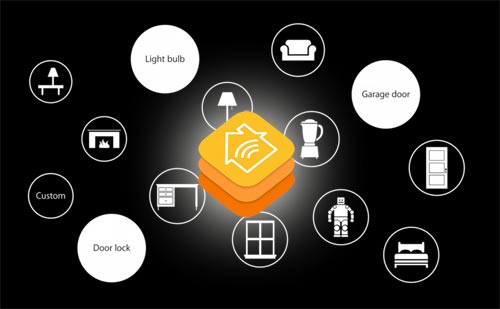One month has already passed since we (George, Oli and Abi) moved into the Swisscom ICT WG. We have determined which ideas we will pursue for the next few months and are in the stage of doing market researches.
During this one month, we got in touch with different smart-home devices and applications from different manufacturers. But products from the big players in the technology industry were missing. With this blog entry, we would like to highlight what Apple, Google and Microsoft have been doing in the smart-home segment and what they have in their pipeline.
Apple HomeKit
At the WWDC’14, Apple presented their smart-home app called HomeKit, which intends to bundle home-automation devices. Compatible devices can be integrated in HomeKit and can be controlled without accessing the app of the device manufacturer. The devices can then also be controlled over Siri or AppleTV.
Although HomeKit has been announced in 2014, the final version is not available yet. Only a trimmed version is available in selected markets. The reason for the delay is that device manufacturers need to fulfill strict requirements to get the compatibility certificate from Apple, hence many companies are still hesitating. But the first compatible devices reached the market this summer/fall, so we can expect the full version of HomeKit in the next few months.

Google Brillo/Weave
In 2012, Google announced Android@Home, but after a few months they stopped talking about it. Later in 2014, Google acquired Nest Labs and Dropcam and started developing devices for home automation. This spring, at the Google I/O conference, they announced Brillo and Weave that aim to standardize the home automation segment.
Brillo is an extremely lightweight operating system (OS) for internet-of-things (IoT) devices. It is a stripped down version of Android that supports Wi-Fi and Bluetooth LE and only needs 128MB disk space and 32MB of memory.
Weave is cross-platform language that simplifies the communication between Brillo operated devices, internet/cloud and Android smartphones.
Brillo has been released in Q3 and Weave is to be released before the end of the year. Both are free at disposal for hardware developers, who then can build their own software on top of them.
Microsoft HomeOS
Microsoft acquired the smart-home app developer R2 Studios in 2013. In 2014 they partnered up with Insteon to develop apps for Windows phones. But already years before these occurrences, Microsoft Research has been conducting research on smart-home. One of the research projects is HomeOS, which was launched in 2010. The idea behind is to highly abstract IoT devices in order to provide a centralized, holistic control.
HomeOS can be installed on any Windows PC, which then serves as a HomeHub. All IoT devices in the home appear as peripherals connected to the hub and can then be intuitively found, accessed and managed. This high abstraction simplifies crosstalk between the devices to a high amount. This again simplifies app development incorporating devices from different manufacturers.
The HomeOS prototype can be licensed for free for non-commercial use. Microsoft uses HomeOS mainly to collect data, which serves as a foundation for IoT device and app development. It is unclear whether HomeOS will be released commercially eventually.
Conclusion
All three companies pursue the goal to centralize the control of a smart-home in an intuitive way, which is the next step in home automation. And they have chosen different approaches to reach it.
So it is certain that the next big thing will come, but if its from Apple, Google, Microsoft or another company, only time will tell!
